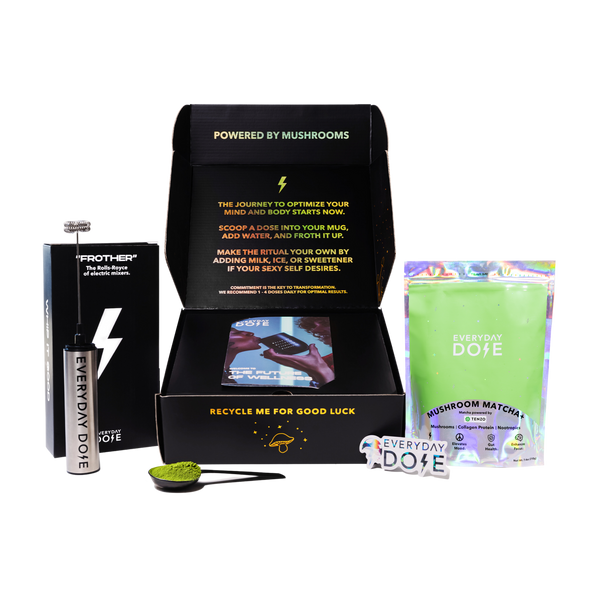4 Ways To Get Rid of Coffee Jitters

Coffee jitters can strike quickly and often without warning. You’re on your way to work enjoying a hot cup of coffee, and then suddenly you’re sweating, shaky, and anxious. If you’re a regular coffee drinker, you probably know exactly what we’re talking about.
When you’re in the thick of it, it can be hard to slow down and think of ways to help the sensation pass — that’s why we put together this guide on how you can help soothe coffee jitters and move caffeine out of your system. Read on for a full breakdown of everything you need to know.
How Does Caffeine Work?
Caffeine works by stimulating the central nervous system. It blocks adenosine receptors in the brain, which normally activate relaxation and sleepiness. This increases our body’s production of dopamine and norepinephrine, which causes the extra alertness and energy we all associate with coffee.
However, not everyone processes caffeine the same way. Sensitivity to caffeine can vary based on factors like genetics, age, and body weight. If you’re more sensitive to caffeine or you tend to rely on a few cups of coffee to get through the day, your body may actually develop a tolerance to it. This can cause you to need more and more caffeine to get the job done.
What Are the Common Side Effects of Caffeine?
Not everyone experiences side effects from their morning cuppas. However, if you’re more sensitive to caffeine or drink a lot of coffee, you’re more likely to see the ugly side of your favorite brew.
Common side effects include:
- Jitteriness
- Increased heart rate
- Restlessness
- Anxiety
- Sleep disturbances
- Digestive issues
- Headaches
- Dehydration
4 Ways To Soothe Coffee Jitters
If you’ve ever had coffee jitters, you know that unfortunately, the best way out is through. That being said, there are still a few ways you can lower your discomfort until they pass.
1. Hydration
Coffee can make you pass more water and leave you parched, so balance it out with water! Drinking water helps flush caffeine from your system and keeps you hydrated, which is key if you’re trying to avoid those shaky, jittery feelings.
Try drinking a glass of water for every cup of coffee you have. It's like a little caffeine detox and should help you feel much better.
2. Exercise
One of the best ways you can help shake off the caffeine jitters is with a little exercise. It’s like hitting the reset button.
Light physical activity gets your metabolism moving, which can help your body process caffeine more quickly. Even a quick walk or a few minutes of stretching can help burn off that extra energy and leave you feeling relaxed.
3. Deep Breathing
When the jitters kick in, make sure you do one thing right away: breathe. Seriously, deep breathing can work wonders.
By taking slow, deep breaths, you can activate your parasympathetic nervous system, which is the “on” switch to your body’s relaxation mode. This helps counteract the caffeine’s energizing effects and cools down the nervous system.
You can start by inhaling for four counts, hold for four, and exhale for four. It’s like meditation but with fewer candles and more coffee. If you want, you can even choose to meditate and focus your thoughts while you practice your breathing to sneak some extra zen into your day.
4. Eat More Fiber
If you’re serious about keeping the jitters at bay, throw some fiber into the mix. Fiber-rich foods like oats, fruits, and veggies help slow caffeine absorption, which means less of it will hit your system all at once.
Pairing your coffee with a fiber-filled breakfast can help keep you steady all morning. While you enjoy your cup of coffee, try adding in a blueberry and granola parfait, some eggs with sauteed veggies, or a green smoothie.
How Can You Avoid Coffee Jitters To Begin With?
Like many things in life, the best way to deal with coffee jitters is to avoid getting them in the first place. Read on for three easy things you can do to keep caffeine side effects away.
1. Watch Your Caffeine Intake
First, it’s important to keep track of how much caffeine you're consuming. Everyone has a different tolerance level, so knowing yours is key. Here at Everyday Dose, we’ve found that a good sweet spot is about 40 mg of caffeine per cuppa. It’s enough to help you feel more awake but generally isn’t enough to cause jitters even in our most sensitive of loved ones.
Don’t forget that caffeine isn’t just in coffee — it’s also hiding in tea, sodas, energy drinks, and even certain medications. Be mindful of these hidden sources to avoid accidental caffeine overload and the jitters that come with it.
2. Go Low-Caf
If you’re prone to jitters, opting for low-caffeine coffee might be a game-changer. You can try decaf coffee, which contains significantly less caffeine, or switch to black or green tea, both of which have a lower caffeine content than your average cup of joe.
However, there are ways you can have your joe and drink it, too. For instance, our Mushroom Coffee+ is made with coffee extract, which provides the robust coffee flavor you’re used to but is significantly lower in caffeine than the average cup of coffee.
If you're looking to reduce caffeine gradually, consider tapering off by mixing decaf with regular coffee. This can help you reduce your caffeine intake without triggering withdrawal symptoms.
3. Try L-Theanine
L-theanine is a natural amino acid found in tea leaves and is known for its calming effects. When combined with caffeine, it helps smooth out the energy boost and can calm side effects like jitteriness.
L-theanine can help encourage feelings of relaxation without causing drowsiness, so it’s a match made in heaven for those who need alertness but want to avoid the stressful edge. It can also help support focus and mental clarity, which is why we add a little extra to all of our mushroom blends.
4. Don’t Drink Coffee on an Empty Stomach
Drinking coffee on an empty stomach can intensify its effects and lead to a quicker absorption of caffeine. This can cause a rapid spike in energy followed by a crash, exacerbating jitters and digestive discomfort. To avoid this, eat a balanced meal or snack before your coffee — look for something with protein, healthy fats, and fiber.
The Bottom Line
Coffee jitters are no joke, especially if you tend to be a caffeine lightweight. One moment, you’re enjoying a nice cup of coffee — the next, you’re a stressed-out mess on your way to work. Luckily, you can help ease jitters by staying hydrated, moving your body, practicing deep breathing, eating more fiber, and avoiding them to begin with.
Coffee jitters are no fun, which is why we’ve put a lot of time into crafting a functional coffee that can actually support your nervous system instead of frying it. Made with lion’s mane and L-theanine to support feelings of relaxation, our Mushroom Coffee+ has everything you love about coffee without the pesky side effects. Try it for yourself today, and don’t forget to visit our blog for more coffee tips!
Sources:
Open for Discussion: Caffeine | American Chemical Society
How To Get Caffeine Out of Your System | Cleveland Clinic
How Does It Work? | School of Medicine | University of Utah Health








